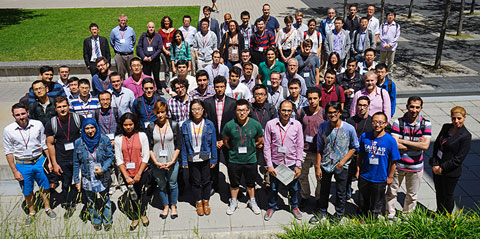
Professor En-hui Yang asked information theorists from across the world to doubt absolutely everything — except, of course, their decision to study information theory (IT).
Yang spoke at the IEEE North American School for Information Theory (NASIT’14), hosted this month by the University of Toronto. The conference brought together 100 graduate students from across North America and abroad to spur learning and dialogue about IT – a field that combines applied mathematics, electrical engineering and computer science to examine how humans handle and transmit information.
“Information theory is very beautiful, and we also know that IT has a profound impact on practice,” said Yang, who proposed we use a “method of doubt” to advance IT research in areas like source coding.
NASIT’14 was organized in collaboration with Professors Stark Draper and Ashish Khisti (both ECE), as well as others in Ontario and Quebec. Researchers and graduate students convened in the Bahen Centre for Information Technology for the four-day conference.
Students promoted their work in “30-second madness” exercises before a poster session each day—each presenter had only half a minute to introduce themselves, the central concepts and highlights of their work, and encourage attendees to stop by their poster.
The conference featured six tutorial-style lectures from world leaders in the field, including Professor Robert Calderbank of Duke University, Professor Andrea Goldsmith of Stanford University, Professor Alon Orlitsky of UCSD, Professor Henry Pfister of Texas A&M, Professor Yang from the University of Waterloo and ECE’s own Professor Brendan Frey.
Unravelling the human genome’s three-billion-letter code
Professor Frey spoke about unravelling some of the mysteries of the human genome’s three-billion-letter code. His group is taking a statistical approach to predicting alternative splicing patterns in different cells—the process by which the DNA code is reassembled into protein-making instructions in the form of messenger RNA.
“It turns out there are a lot of deviations that cause diseases in the process of splicing,” said Frey. “We think we have a regulatory model that will predict changes…so now we’re looking at many different diseases,” including neural muscular atrophy and autism spectrum disorder.
On the third day of the conference, the academic focus was complemented with career-oriented events. Professor Robin Sacks, the director of research at U of T’s Institute for Leadership Education in Engineering (ILead), led a dynamic workshop that encouraged students and faculty to reflect on and discuss what leadership is, to identify the leadership skills they already have, and to recognize those they need to acquire to be successful in their careers.
There was also an academic- and industrial-themed panel titled “The Road Ahead” where six panellists shared their own career paths and hard-earned wisdom. Panellists included Calderbank and Goldsmith, as well as Professor Laura Balzano of the University of Michigan, Petros Boufounos of Mitsubishi Electric Research Laboratories (MERL), and two U of T Engineering ECE alumni: Behrouz Khoshnevis of the Royal Bank of Canada and Adam Tenenbaum of Telus.
“Our intent was to provide the students a deep, informal and fun learning experience that covered central topics of information theory – multimedia compression, wireless and error-correction coding,” said Draper. “And also to demonstrate how information theoretic thinking has impact on other fields, such as genomics, large-dimensional statistics and signal processing.
NASIT is an annual event sponsored by the IEEE Information Theory Society. This was the seventh school, and was the first to be held in Canada. The location of NASIT’15 will be announced this coming July.




